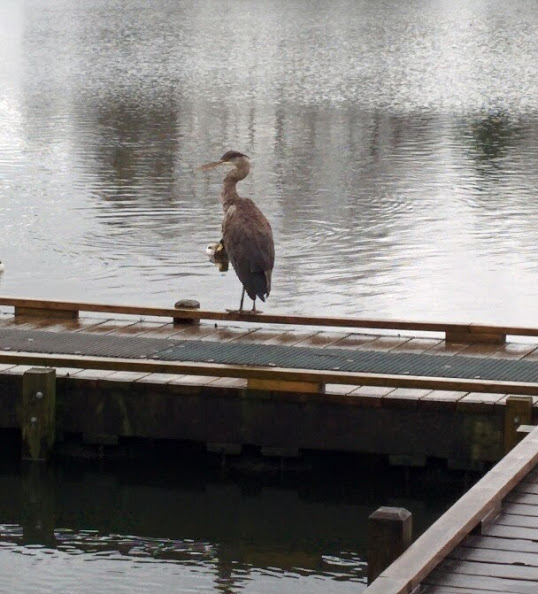On my 45-minute run on Saturday I ran around Como Lake, and it was raining very hard! I noticed that there is a new local resident: a young great blue heron.
This little guy kept me company, somewhat, along with the ducks, for the lake trail is small (1k around). I ran around it 6x in my allotted time. Each time I passed the heron, I smiled. It is a beautiful creature. Seeing wildlife, and owning pets, makes me happy. Our pets (cats) definitely all have unique personalities, and one of them, Radagast, is particularly responsive to me. He’s kind of a goofball. Our cats are indoor-only, but if the door remains open more than a split-second, he dashes outside. In the spring and summer, he is very aggressive, through the screens, with wildlife out back or in our side yard. He will go from window to window, huffing, prancing, etc. Yet, he will snuggle with me for hours at night, sometimes falling asleep on my right shoulder, purring very loudly. He’s so sweet despite his otherwise desire to get outside and taunt things.
Last night Radagast was perched upon my shoulder as I watched Wild Horse Wild Ride, a film about some riders who rode wild horses (mustangs) they’d trained, from the Mexican to Canadian border. It was a very good documentary. They were trying to raise awareness of some issues, most particularly that land management has governed that only so many wild horses can live sustainably on western lands and that now many wild horses are kept in pen captivity due to trying to keep the horses per land reasonable (otherwise, there is scarcity of food, especially during increasing droughts). In my mind, there’s really no reason to continue the unsustainable practice of beef and dairy cattle ranching, so I side with the wild horses being able to get more land–but there is always compromise in these situations, and in this documentary, the riders were raising awareness of the multiple issues surrounding wild horses and showing how sturdy they are. Adoption rates have gone down, while wild horse populations are going up, so the guys doing the movie wanted more people to know about why these animals would be great to adopt.
What struck me the most was these riders’ love for the natural beauty of the West. From fly-fishing to riding through mountains, deserts, and along rivers, they all seemed to hope these areas would be untouched, still beautiful, and clean a hundred years from now, and more. The photography and cinematography was absolutely stunning. The second most endearing thing to me was the way that these riders genuinely cared about their horses. While the doc showed that wild horses need to be trained; once trained, the relationship with their owners in this film was very sweet. Caring. That’s how, I wish, all of us could be.
Call me a luddite, but I don’t think our needs should ever come above those of animals, which is why I disagree with so many greedy corporate practices that take away animal habitats just for palm oil or some other natural resource. I think from day one, if we would have had some foresight to the nature we use for our benefit, and, instead of saying, “I can make money from this venture,” we would have thought instead, “If we take this resource, how will it affect the entire ecosystem on which we depend; how does it look 50 years down the road, 100 years down the road; why are we killing animals for our own benefit, and why is that necessary?”
Speaking of animals, I am part of an emergency response team at the school I work at (the largest school emergency response organization in our province), and being still a new member, as of last year, I have struggled with which area to become involved in. I started as a scribe and did psychological first aid training and light urban search and rescue training. I’m also a fire warden. Well, after talking more with the manager of our team, I have decided to go into the pet emergency care, which is new. It basically helps people prepare for emergencies with their pets (tags, collars, care) and figure out best evacuation routes and day-of handling.

